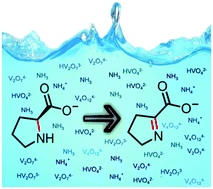Vanadium(v) oxoanions in basic water solution: a simple oxidative system for the one pot selective conversion of l-proline to pyrroline-2-carboxylate†
Abstract
The unprecedented, direct chemical oxidation of L-proline to pyrroline-2-carboxylate was achieved in water (pH 9–10) by means of NH4VO3/NH3 or V2O5/MOH (K = Na, K), and the anion was fully characterized as ammonium or alkaline metal salts. Quantitative yield and higher atom economy performance were achieved with the latter system, the alkaline salts being more stable than the ammonium one. Different mixed valence V(IV)/V(V) compounds precipitated from the reaction mixtures depending on the nature of the employed base. A possible reaction mechanism is proposed according to DFT calculations. The analogous reaction of trans-4-hydroxy-L-proline with NH4VO3/NH3 afforded pyrrole-2-carboxylic acid in 81% yield, while sarcosine underwent prevalent decomposition under similar experimental conditions. Instead, no reaction was observed with primary (glycine, L-alanine, L-phenylalanine) and tertiary α-amino acids (N,N-dimethyl-L-phenylalanine, N,N-dimethylglycine).



 Please wait while we load your content...
Please wait while we load your content...